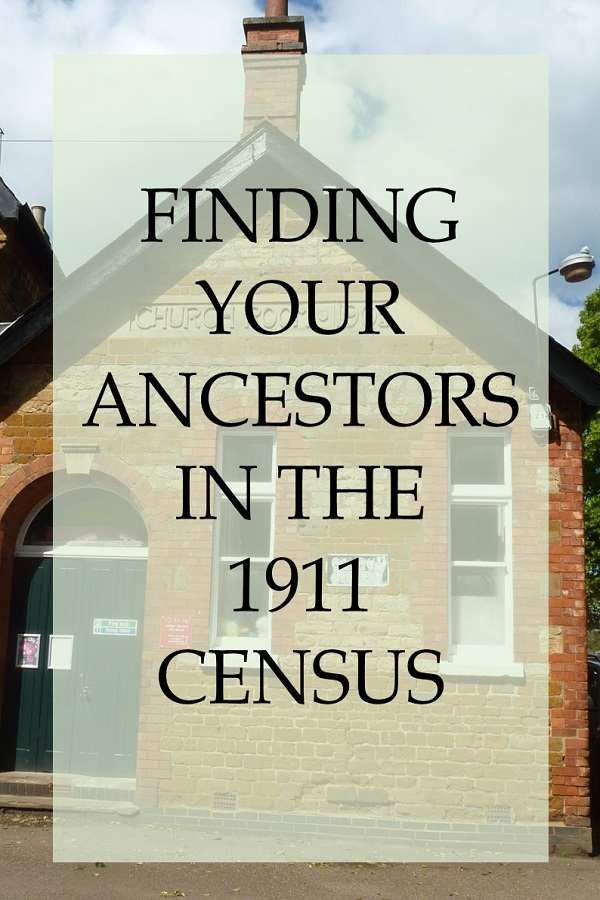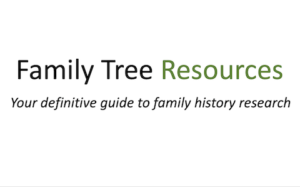
The 1911 Census of England and Wales was taken on 2 April 1911, and contains much more detail than that provided on any previous return. It is a unique census because it is the first census that allows you to see your ancestor’s handwriting as the original forms were kept.
It is considered to be one of the most important census returns because it gives details of a family before the outbreak of World War 1, and includes the details of many young men who unfortunately died in the war.
It lists the name and surname and age of everyone living in the house at the time of the census, and their relationship to the head of the household. Visitors, servants, lodgers and boarders are also listed, along with the the individual’s marital status.
Full details of British personnel stationed overseas was also recorded in the census.
1911 Census Address
The first thing you will notice when perusing the 1911 Census is that the address is not written in the first column as it was in previous census returns. It is now written in the lower right corner of the return, along with your ancestor’s signature.
It is wonderful to see your ancestor’s own signature!
1911 Census Headings
Name and Surname
The name and surname of each individual living in the house on census night was recorded on the census.
Some householders filling in the schedule did not fully understand what they had to do, and entered people who were living away from the family home on census night.
This confusion meant that some people may have been recorded twice – once in their family home, and again in their abode at the time of the census.
Another option is that the person was not entered on the census at all if they were living away from home, and were also not recorded where they were living, especially if it was just for the one night.
Please remember that where a person was living on one night was not necessarily where they spent the majority of their time.
Relationship to the Head of the Family
The individuals relationship to the head of the family is also recorded. This was also open to interpretation because I have known instances where the householder stated that his wife’s niece or nephew was his niece or nephew.
You should look at both the husband’s and wife’s family if this was the case. This is also true if the head of the house was a widow or widower.
Age at Last Birthday and Sex
Each householder’s age was entered in this column.
Some householders lied about their age, however, so look for a few years either side of the date if you are unable to find a record for your ancestor. Some gave inaccurate information because they simply did not know when they born.
The sex of the individual was also recorded in this column.
Particulars as to Marriage
Some of the new columns added to the 1911 census were with regard to marriage and fertility, and it became known as the fertility census.
Columns were added to record the duration of the present marriage and the total number of children born alive to that couple. The figure was split between two more columns in which the number of children alive and/or dead was recorded.
The government was becoming increasingly concerned about the poor health of the nation in 1911. In order for the country’s development to continue, a large and healthy workforce was required.
This concern led to women being asked to provide details of how long their marriage had lasted, how many children had been born to that marriage and how many had died.
This new information could be of particular importance to you because it can help you to discover children who may previously have been unknown to you, and can also help you to find other children born to the couple who could have died prior to 1911.
This addition to the Index was especially useful to me because I was able to find another child born to my ancestors that I did not know existed because he was born and died in 1906.
This research was helped enormously by the fact that the mother’s maiden name is recorded in the updated GRO Index available on the General Register Office’s website.
If you wish to discover more about the GRO Index and how it can help your family history research, please read my article: using the GRO Index for Family History Research.
This may also help you to determine if this was your ancestor’s second or subsequent marriage. If many children are listed, but some are older than the ‘years the present marriage has lasted’, it may be prudent to check if either the husband or wife had been married previously.
It is also possible that the householder recorded any children as being stepsons and stepdaughters, making it much easier to determine which children belong to which marriage.
You may find an entire family you did not previously know about!!
Profession or Occupation
Employment was recorded in much more detail in this Census – columns were added to state the Industry or Service with which the worker was connected and whether or not they worked at home.
The householder had to be more precise about the branch of profession, trade or manufacture they were involved in.
If they were engaged in any trade or manufacture, the kind of work they undertook, and the item made or material dealt in had to be indicated, along with the industry or service they were connected with.
Occupation codes were used so that the government could discover which industries were growing or declining. These were written in blue on the census return.
To find out which occupation code was written for each industry, please read this article from FindmyPast regarding occupation codes.
It also stated whether or not they were an employer (domestic servants did not count), a worker (working for a employer), or working on their own account. This was only if they did not work for others or worked for a trade employer. If the person worked at home, this also had to be detailed.
The detail regarding occupations is important to you because it will help you to find out more about the daily lives of your ancestors.
My ancestor William George Baker stated that he was an engineer’s driller in the electrical industry. This was noted as being occupation code 636, and was stated as being ‘other electrical apparatus makers; electrical fitters – other’.
My ancestor’s brother Charles Carrington Baker, who was living with his William and his family in 1911, was stated as being a Store Assistant, for which occupation code 629 was allocated, which was ‘other or undefined workers in engine and machine making – others’.
Birthplace of Every Person
Your ancestor’s birthplace was also recorded, and because they completed the schedule, it sometimes gives more detail of their place of birth, listing their actual birth address, which was the first time this was recorded in this much detail.
Some householders did not know where they had been born, however, so either entered NK or not known in this column, which is always very disappointing.
Each place of birth was assigned a code, which was written in red on the census by the enumerator so this information could be categorised. To discover more about birthplace codes, please read the article from FindmyPast regarding birthplace codes.
My ancestor William George Baker was born in Ipswich, Suffolk, which was categorised as code 201, but his brother Charles, his wife Elizabeth, and children were all born in areas of London, which was categorised as code 000.
If a person was born outside of the United Kingdom, their birth country was recorded. If the person was born outside the UK, but in another part of the British Empire, the name of the dependency or colony was recorded, along with the Province or State.
Nationality of Every Person Born in a Foreign Country
There was also a place to state whether the person was a British Subject by parentage, Naturalised British Subject (also gives year of naturalisation) or if of foreign nationality, whether French, German, Italian, Russian etc.
Infirmity Recorded in the Census
A column was provided on the census so that the head could state if any members of the household were ‘totally deaf’ or ‘deaf and dumb’, totally blind, a lunatic or imbecile or were feeble-minded. The age at which the person became inflicted was also recorded.
Original 1911 Census Schedules
This is the first time the original schedules were not destroyed, so you are able to see your ancestor’s own handwriting, but please be aware that approximately 5 percent of these schedules were damaged by water several years ago, so they are more difficult to read.
You can also read any additional comments they may have added to the record.
Census Schedule
The numbers of the Registration District, Registration Sub-District and Enumeration District were entered on the schedule, which was completed by the enumerator.
The head of the family or separate occupier was also entered on this sheet, along with the address of the property.
Suffragettes – The Boycott of the 1911 Census
Some women boycotted the census to vent their frustration that the government had not granted the vote to women.
In some instances, women refused to complete the form and in other instances women stayed away from home on the night, so they were not able to be recorded.
The suffragettes’ rallying call was that ‘if women don’t count, neither shall they be counted’ and some wrote ‘votes for women’ across the schedule.
Emily Wilding Davison hid in a cupboard in the Chapel of St Mary Undercroft in the House of Commons. The form states that she was ‘found hiding in crypt of Westminster Hall’.
Other Information Recorded in the 1911 Census
The number of rooms in the house was also recorded, and the head of the house had to sign the schedule to certify that the information provided was correct to the best of his or her knowledge. This is especially exciting because you are able to see your ancestor’s signature.
1911 Census Headings at a Glance
- Name and Surname
- Relationship to Head of Family
- Age (last birthday) and Sex
- Condition – Single, Married, Widower, Widow (aged 15 years and upwards)
- Completed years the present Marriage has lasted
- Children born alive to present marriage: followed by Total Children born alive
- Children still living
- Children who have died
- Personal Occupation
- Industry or Service with which worker is connected
- Whether employer, worker or working on own account
- Whether working at home
- Birthplace
- Nationality of every Person born in a Foreign Country
- Infirmity
How to Access the 1911 Census
You are able to view the census at the National Archives and the National Library of Wales.
You are also able to search the 1911 Census online at Ancestry and FindmyPast.
Ancestry
Ancestry is great for anyone who does not have the time to, or is unable to, visit Record Offices or Libraries.
It is especially good if you wish to access records from the comfort of your home.
Read my in-depth review to find out more about its features, advantages, and disadvantages.
FindmyPast
FindmyPast is good for anyone, whether they are just starting their family history journey, or have already conducted some research.
It is especially good for people who wish to read newspaper articles.
Read my in-depth review to find out more about its features, advantages and disadvantages.
